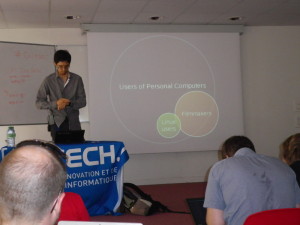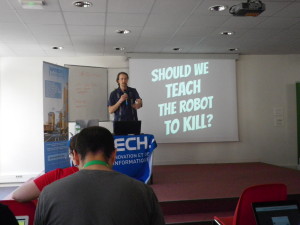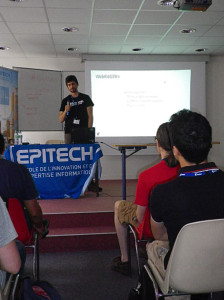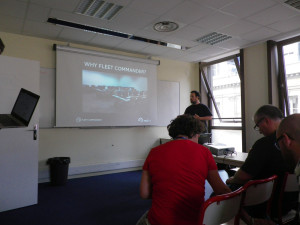The second day of GUADEC was also full of interesting talks. Jeff Fortin spoke about the video editor Pitivi. Nathan Willis devoted his keynote to software for automotive and the opportunities for open source software in this area.
There have also been a lot of changes in the Web browser and Zeeshan Ali talked on improvements in GNOME Boxes. The biggest news of the day is an announcement of Fleet Commander which should provide tools and infrastructure for large desktop deployments. Something the Linux desktop has been severely lacking.
Pitivi
The second day of GUADEC started with a talk on the video editor Pitivi. Jean-François Fortin Tam who has been taking care of the project in terms of organization and marketing started with the history of the project. It is a nice coincidence that the Pitivi project was started, in 2004, at EPITECH where GUADEC is taking place this year.
Jeff has a degree in marketing and it’s probably one of the reasons why Pitivi could be an example for other projects how to do it. They made an analysis of their potential user base and found out it was quite small because it’s more or less an intersection of Linux desktop users and people who edit videos. They also asked users in the survey what features they’d like to see in Pitivi in the future, but results weren’t very clear: many features and none of them received significantly more votes than others. So there are no top five wanted features.
He also spoke about the fundraising which they started together with The GNOME Foundation. They aimed at €32,000 and have so far received around €19,000 while the fundraising is still going on. Jeff said that it’s really frustrating to see stupid things such a potato salad receive ten of thousands of dollars in fundraising while open source projects struggle to get at least a portion of such amounts.
The second part of the talk was delivered by a Google Summer of Code student Lubosz Samecki who has been working on Pitivi. There are larger changes going on. For example switching to OpenGL for much smoother transitions which was also demoed during the talk. Everyone was invited to a Pitivi hackfest which will take place later in the BoF part of GUADEC.
Software for Automotive
The keynote of the day was delivered by Nathan Willis, an LWN editor, typeface designer, and author. (Nathan will be covering Flock 2014 for LWN, so you can meet him in Prague if you attend Flock!). The keynote’s title was “Should We Teach The Robot To Kill”?, but it was not really about Terminator-like killing machines.
Nathan spoke about software for automotive and what opportunities open source software has in this area. There are two domains of software for automotive: IVI (In-Vehicle Infotainment), ECU (Electronic Control Units). The former one takes care of entertainment and providing information while the latter one is responsible for actually running the car. According to Nathan software for automotive brings new challenges. We’re used to having a car for ten, fifteen years, but is anyone going to willing to support its software for such a long time?
He also described the landscape of open source projects for automotive and mentioned the most interesting ones such as GENIVI, Automotive Grade Linux, Tizen IVI, Open Automotive Alliance. And any connections between GNOME and automotive? Nathan says that GNOME could be more friendly to IVI. That would put it ahead of competition. GENIVI and Tizen IVI also use several GNOME components: GStreamer, BlueZ, Cairo, Avahi,… Some projects even use GTK+. At the end of the keynote, Nathan showed his 2005 Mustang he started hacking on. How cool is that?
Web and WebKitGTK2
After a lunch break, the conference program continued with a talk on the Web (Epiphany) browser. Eduardo Lima of Igalia spoke about what had been going on in the last six months and what plans they have for Web and underlying WebKitGTK+.
The big news is that Web now supports one process per tab which means that one page won’t take down the whole browser. It also improves security because you can put vulnerable data in a separate address space. There are also downsides of this change that they had to fight. The browser tends to be more memory hungry and Web extension setups are more complex.
And other changes? WebKit1 has been completely removed from the trunk. Plugins in Web are synchronously scanned on first use which can’t be completely avoided, but now it’s at least done just once and cached for later. The Speed Dial-like overview has been implemented in HTML and due to this they could remove thousands of lines of code.
And the future? Eduardo said that WebKitGTK+ 2.6 is currently a bit behind schedule. They’re working on WebRTC implementation and initial WebCrypto spec support. They’re also planning to add sandboxing for web processes which would improve security of Web even more. Web also doesn’t have a dialog for blocking encrypted connection with invalid certificate like other browsers. It should change, too. Moreover they’d like to bring back a pop-up blocker.
Web used to be just another browser, but Igalia has been investing a lot into it lately and it’s becoming a really interesting browser. Some Fedora contributors have even suggested that Web becomes the default browser in Fedora Workstation. It’s not the case now, but it might be in the future.
Boxes
Many Fedora users may know GNOME Boxes because it has become a popular option for desktop virtualization in Fedora. The lead developer of Boxes Zeeshan Ali gave us an update on what had recently changed in Boxes and what’s planned. Boxes now support express installation of Fedora, RHEL, Windows XP, 7 & 8, and can be a client for oVirt machines. According to Zeeshan Boxes are much more stable than in the preview stage and its accessibility is almost complete.
He also mentioned what components Boxes are currently using: libvirt, libvirt-glib, SPICE, libosinfo, GTK+, libgd. And the future? In my opinion the biggest feature they are working on are snapshots. Users will be able to make snapshots of their virtual machines, for example before upgrading the guest system. Boxes is considered an easy-to-use desktop virtualization application, and anyone who wants more advanced features is advised to go for virt-manager. Zeeshan would like to make Boxes more attractive even for power users by adding advanced features in the future.
Fleet Commander
The last talk I attended on the second day was “Fleet Commander: making GNOME shine on large deployments” by Alberto Ruiz and I must say it was also the most interesting talk of the day because it was announcing a major innovation in GNOME. Fleet Commander should make it easier to deploy and customize desktops on large deployments. The architecture consists of a central profile store that is using technologies which are common in enterprises (HTTP, LDAP, AD,…), client-side daemon, and management interface.
The way you can customize a desktop and make a profile out of it is simply great. When you want to create a new profile a HTML5 SPICE session of the desktop system is started, you make changes in system and app settings and a daemon running in the session is tracking and saving all changes. Then you can save the changes as a new profile and apply it on desktop computers of certain users or a group of users. You have an option to restrict users from changing settings applied by you. The leading developer of Fleet Commander is Matthew Barnes, who was a developer of Evolution for many years. It’s still in early stages: the builder tool is finished, but they need to work on making it more robust, only GSettings apps are currently supported.
In the future, they want to go beyond that, supporting Firefox, Chrome, LibreOffice, perhaps KDE apps, bookmarks, GOA and email accounts, repositories and pre-installed apps (you as a sysadmin can for example install a special marketing tool from a company’s repository only on computers of marketing people). Fleet Commander has a potential to be a game-changer in enterprise Linux desktop adoption because it’s something the Linux desktop has been lacking for a long time.
The conference day ended with lightning talks of interns either from Google Summer of Code or Outreach Program for Women. Each of them had a few minutes to present what they have been working on and achieved. There were many cool things. For example GNOME Keysigning that should make participating in key signing events much easier.
The evening program consisted of the traditional GUADEC football match and picnic in a park to relax after a busy day at the conference.
See also, GUADEC 2014: Day One.









